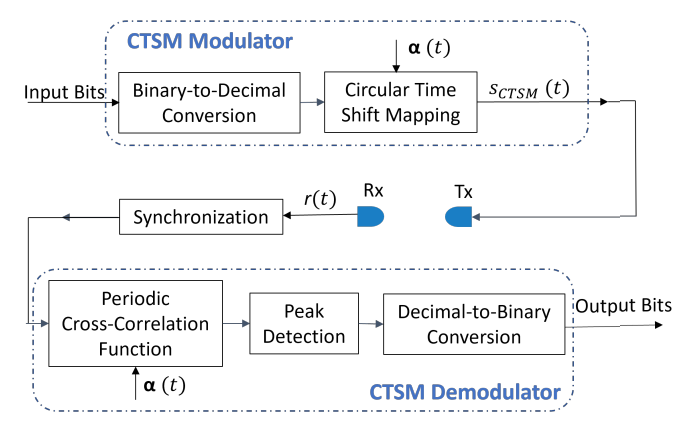UW-CTSM: Circular Time Shift Modulation for Underwater Acoustic Communications
Research | | Links:

In Underwater Acoustic Communications (UACs), Coherent Phase-Shift Keying (CPSK) modulation has been widely used, which conveys data by changing the phase of the carrier waves. However, the CPSK requires a complicated demodulator to compare the phase of received signals to a reference signal. As for the linear signal with coherent detection, where the noise and Doppler effects work on the transmitted symbols directly by introducing the phase offset, the accuracy of CPSK demodulation can be influenced dramatically. In contrast, the Pulse Position Modulation (PPM) is power-efficient and does not need to track the carrier phase information. Instead, what we only care about is the power peak position of each received PPM frame, so that the phase offset caused by noise hardly has an impact on the PPM signal transmission and the high cost of phase detection can be discarded. In PPM modulation, data are transmitted by different pulse positions which are in proportion to the amplitude of the message signal in the time domain, while the pulse width and amplitude are the same. In this case, all of the interest information is concentrated on the peak position per PPM frame. However, PPM is sensitive to the multipath delay that arises in the underwater acoustic channel.
In this work, we derive a new modulation scheme for UACs, called Circular Time Shift Modulation (CTSM), which can achieve a significant gain of several dB compared with the Pulse Position Modulation (PPM). To solve the issues of multipath delay plus additive noise, Zero-Correlation-Zone (ZCZ) signals are utilized, whose auto-correlation function has zero-sidelobe zone. At the transmitter side, the data are mapped to the corresponding circular time shifts in ZCZ signals. At the receiver side, the periodic cross-correlation function between the received ZCZ signals and the initial ZCZ signal will be calculated. The position of the peak of the periodic cross-correlation function is exactly the time shift, and the data can be demodulated successfully. The difference between the proposed approach and the PPM is that, in the proposed approach, the peak detection is done with the periodic cross-correlation between the received ZCZ signals and the initial signal, while in the PPM, the peak detection is done with the received PPM signals.
Personnel:
- Zhuoran Qi, PhD candidate, ECE Department, Rutgers University (Link to Profile)
- Dr. Dario Pompili, PI, ECE Department, Rutgers University, New Jersey (Link to Profile)
Publications:
- Z. Qi and D. Pompili, “UW-CTSM: Circular Time Shift Modulation for Underwater Acoustic Communications,” 2022 17th Wireless On-Demand Network Systems and Services Conference (WONS), Oppdal, Norway, 2022, pp. 1-8, doi: 10.23919/WONS54113.2022.9764464.

